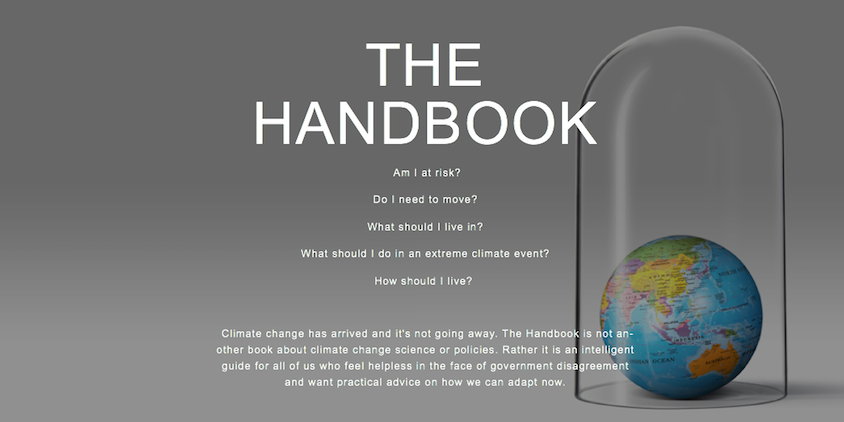 The Handbook: Surviving and Living with Climate Change
The Handbook: Surviving and Living with Climate Change
by Jane Rawson and James Whitmore (Transit Lounge, $29.95)
Launching this September, The Handbook combines the thorough detail and exhaustive research of a science text with the format of what could only be described as a guide for doomsday preppers.
While that may make this 300-page book sound like it could be satirical in nature, co-author Jane Rawson insists that the subject matter is far from lighthearted. Covering both practical and philosophical considerations regarding how to prepare for the kind of changes predicted to occur in the next 20 to 50 years, The Handbook is aimed to inspire action in both those who are already seeking ways to protect themselves and those who are yet to be convinced that climate change is really such a pressing matter.
Having previously worked in the role of environment and energy editor for The Conversation, Rawson had no trouble explaining to us what the book was all about, as well as how it may just save some lives one day.
Jane, what’s the purpose of this book and who is it for?
Certainly a part of our mission is to impart at least some sense of urgency on the topic. Part of that is the adaptation message; there’s always so much talking going on in Canberra about reducing our emissions, but it doesn’t feel like many people are willing to consider what they should be doing in the meantime.
While the book isn’t officially launched yet, we hope it will offer different things to different people. Some people are already thinking about these issues and for them climate change is already a big deal. For them, this book will be both useful and practical. For most other people, we really just want to highlight the fact that climate change is something that we’re going to be stuck with. It’s already here and it’s just going to get worse. Some people still haven’t come to terms with that yet – they think it’s just an issue for other species or their grandchildren or the people living 50 years from now who will have to deal with it. Unfortunately that’s just not the case.
What’s your own personal motivation for co-authoring such a publication?
To be honest, I’m a bit of a worrier myself and that’s one of the reasons I wanted to write this book. I wanted to explore these topics for myself. Living in Melbourne I’m highly aware that our own forecast isn’t great. Water supply will become an issue sooner or later. The increasing heat will limit options for staying affordably cool and safe. In my current building I can’t have solar panels installed on the roof, so all of this raised a lot of questions for me. Researching and writing this book has meant I now have a resource that can inform my strategy into the future.
The book covers a wide variety of topics, including bushfire and flood safety, growing food and even how to use sewage as an energy source. Do any of these topics take priority over any other? Where should we begin?
What we’re hoping people do is, rather than worrying a generalised kind of way about climate change as some vague environmental issue, that they instead look around their own homes and neighbourhoods and ascertain how climate change is likely to impact their lives. Unfortunately as urban encroachment continues into coastal areas, floodplains and the bush, the risk of floods and fires become a very real concern. People should ensure they develop a comprehensive plan to deal with any of the scenarios they may encounter as detailed in the book, before using it to prepare accordingly.
Mostly, I hope people come to see this book as a wake-up call to stop thinking of these issues as just an environmental concern. Too often do we consider reducing greenhouse gases as a win for environmentalists, but it’s not as simple as the planet versus the economy. Climate change needs to be viewed as a threat to everything we do as a society.
This book isn’t about saving the planet, it’s about potentially saving your own life.


